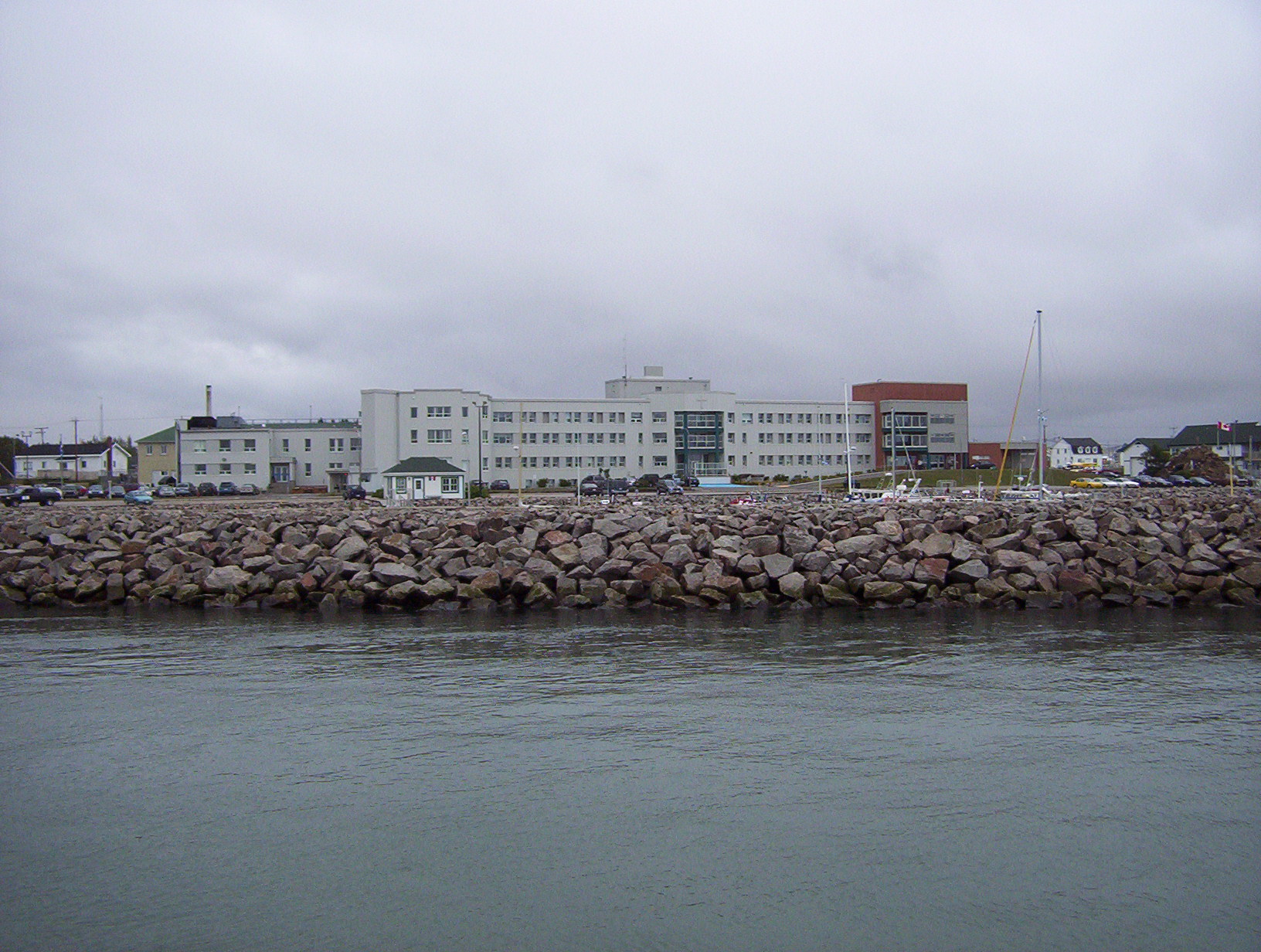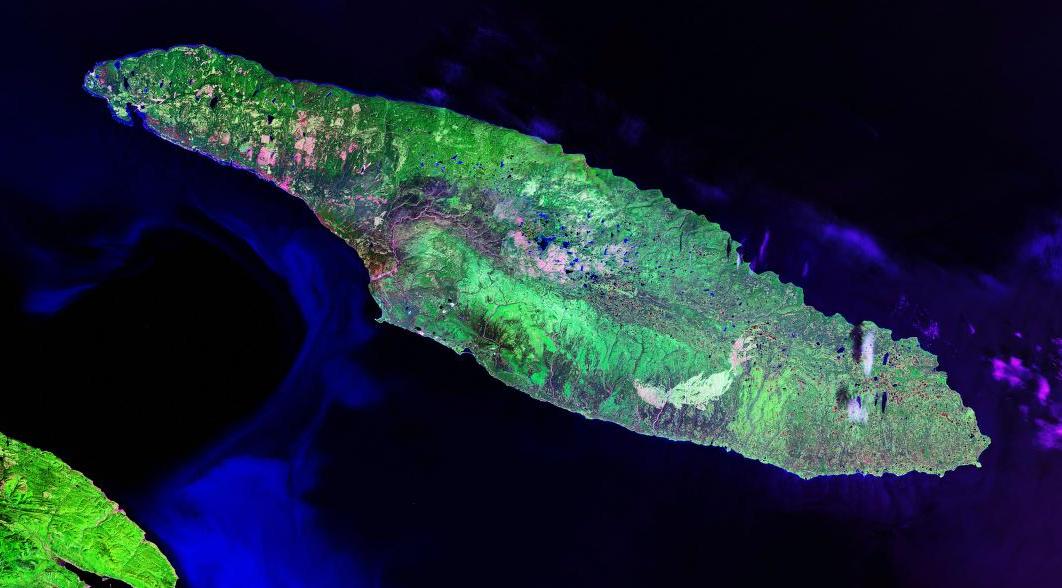|
Havre-Saint-Pierre, Quebec
Havre-Saint-Pierre is a town on Pointe-aux-Esquimaux, which is on the Quebec north shore (Côte-Nord) of the Saint Lawrence River in Canada. Located along Route 138 some east of Sept-Îles, it is the largest town and seat of the Minganie RCM, and home to many government, municipal, and regional services. Historically, the town's first inhabitants came from the Magdalen Islands in the nineteenth century. As a result, the people of the town speak a dialect much more closely related to Acadian French than to Quebec French. Other important geological features near the town include the Romaine River to the north and west, les Chutes Manitou, on the Manitou River to the west, l'Ile du Havre, less than a kilometre offshore from the town, and Anticosti Island, which on clear days can be seen to the south of the town. History In 1857, a group of Acadian families from the Magdalen Islands, who had been deported from Savannah (Georgia, USA), settled on Eskimo Point (''Pointe aux Es ... [...More Info...] [...Related Items...] OR: [Wikipedia] [Google] [Baidu] |
Municipality (Quebec)
The following is a list of the types of local and supralocal territorial units in Quebec, including those used solely for statistical purposes, as defined by the Ministry of Municipal Affairs, Regions and Land Occupancy and compiled by the Institut de la statistique du Québec. Not included are the urban agglomerations in Quebec, which, although they group together multiple municipalities, exercise only what are ordinarily local municipal powers. A list of local municipal units in Quebec by regional county municipality can be found at List of municipalities in Quebec. Local municipalities All municipalities (except cities), whether township, village, parish, or unspecified ones, are functionally and legally identical. The only difference is that the designation might serve to disambiguate between otherwise identically named municipalities, often neighbouring ones. Many such cases have had their names changed, or merged with the identically named nearby municipality sinc ... [...More Info...] [...Related Items...] OR: [Wikipedia] [Google] [Baidu] |
Sept-Îles, Quebec
Sept-Îles ( Quebec French pronunciation : , French for "Seven Islands") is a city in the Côte-Nord region of eastern Quebec. It is among the northernmost locales with a paved connection to the rest of Quebec's road network. The population was 25,686 as of the 2011 Canadian census. The town is called Uashat, meaning "bay" in Innu-aimun. The city is well known for having major iron companies like Iron Ore Company of Canada and the Cleveland-Cliffs mining company. The city relies heavily on the iron industry. Sept-Îles has among the highest average wages and the highest average wage increases. The only settlements on the paved road network that are farther north are Fermont, Radisson and Chisasibi, the latter two of which are in the extreme western part of the province at the north end of the James Bay Road. The only other settlements at higher latitudes in the province are mostly isolated Cree, Innu, or Inuit villages, with access limited to seasonal gravel roads. Sep ... [...More Info...] [...Related Items...] OR: [Wikipedia] [Google] [Baidu] |
Baie-Comeau
Baie-Comeau (; 2021 city population 20,687; CA population 26,643) is a city located approximately north-east of Quebec City in the Côte-Nord region of the province of Quebec, Canada. It is located on the shores of the Saint Lawrence River near the mouth of the Manicouagan River, and is the seat of Manicouagan Regional County Municipality. There are two urban area population centres within the city limits: Baie-Comeau proper, with a population of 9,100, and Hauterive, with a population of 11,147, as of the 2021 Canadian Census. The city is named after the adjacent Comeau Bay, which is named in honour of Napoléon-Alexandre Comeau, a Québécois naturalist. Baie-Comeau is the birthplace of former Prime Minister of Canada Brian Mulroney. History The oldest part of Baie-Comeau is the area known as ''Vieux-Poste'' (Old Post) near the mouth of the Amédée River where in 1889, the Saint-Eugène-de-Manicouagan Mission was founded by Eudists. In 1898, the first sawmill in the Côte ... [...More Info...] [...Related Items...] OR: [Wikipedia] [Google] [Baidu] |
Saint Peter
) (Simeon, Simon) , birth_date = , birth_place = Bethsaida, Gaulanitis, Syria, Roman Empire , death_date = Between AD 64–68 , death_place = probably Vatican Hill, Rome, Italia, Roman Empire , parents = John (or Jonah; Jona) , occupation = Fisherman, clergyman , feast_day = , venerated = All Christian denominations that venerate saints and in Islam , canonized_date = Pre- Congregation , attributes = Keys of Heaven, Red Martyr, pallium, papal vestments, rooster, man crucified upside down, vested as an Apostle, holding a book or scroll, Cross of Saint Peter , patronage = Patronage list , shrine = St. Peter's Basilica Saint Peter; he, שמעון בר יונה, Šimʿōn bar Yōnāh; ar, سِمعَان بُطرُس, translit=Simʿa̅n Buṭrus; grc-gre, Πέτρος, Petros; cop, Ⲡⲉⲧⲣⲟⲥ, Petros; lat, Petrus; ar, شمعون الصفـا, Sham'un al-Safa, Simon the Pure.; tr, Aziz Petrus (died between AD 64 and 68), also known as Peter the Ap ... [...More Info...] [...Related Items...] OR: [Wikipedia] [Google] [Baidu] |
Savannah, Georgia
Savannah ( ) is the oldest city in the U.S. state of Georgia and is the county seat of Chatham County. Established in 1733 on the Savannah River, the city of Savannah became the British colonial capital of the Province of Georgia and later the first state capital of Georgia. A strategic port city in the American Revolution and during the American Civil War, Savannah is today an industrial center and an important Atlantic seaport. It is Georgia's fifth-largest city, with a 2020 U.S. Census population of 147,780. The Savannah metropolitan area, Georgia's third-largest, had a 2020 population of 404,798. Each year, Savannah attracts millions of visitors to its cobblestone streets, parks, and notable historic buildings. These buildings include the birthplace of Juliette Gordon Low (founder of the Girl Scouts of the USA), the Georgia Historical Society (the oldest continually operating historical society in the South), the Telfair Academy of Arts and Sciences (one of the South's ... [...More Info...] [...Related Items...] OR: [Wikipedia] [Google] [Baidu] |
Acadians
The Acadians (french: Acadiens , ) are an ethnic group descended from the French who settled in the New France colony of Acadia during the 17th and 18th centuries. Most Acadians live in the region of Acadia, as it is the region where the descendants of a few Acadians who escaped the Expulsion of the Acadians (aka The Great Upheaval / ''Le Grand Dérangement'') re-settled. Most Acadians in Canada continue to live in majority French-speaking communities, notably those in New Brunswick where Acadians and Francophones are granted autonomy in areas such as education and health. Acadia was one of the 5 regions of New France. Acadia was located in what is now Eastern Canada's Maritime provinces, as well as parts of Quebec and present-day Maine to the Kennebec River. It was ethnically, geographically and administratively different from the other French colonies and the French colony of Canada (modern-day Quebec). As a result, the Acadians developed a distinct history and cultur ... [...More Info...] [...Related Items...] OR: [Wikipedia] [Google] [Baidu] |
Anticosti Island
; moe, Notiskuan; mic, Natigostec , sobriquet = , image_name = RiviereHuileAnticosti.jpg , image_caption = Salmon fisherman on Rivière à l'Huile , image_map = , map_alt = , map_size = , map_caption = , pushpin_map = Canada Quebec , pushpin_label = , pushpin_label_position = , pushpin_map_alt = , pushpin_relief = , pushpin_map_caption = , coordinates = , etymology = , location = Gulf of Saint Lawrence , grid_reference = , archipelago = , waterbody = , total_islands = , major_islands = , area_km2 = 7,95 ... [...More Info...] [...Related Items...] OR: [Wikipedia] [Google] [Baidu] |
Romaine River
The Romaine River is a river in the Côte-Nord region of the Canadian province of Quebec. It is long. It is not to be confused with the Olomane River that is to the east and had the same name for a long time. It flows south into the Gulf of Saint Lawrence. Location The Romaine River is about long, none of which is in Labrador since the east bank of the river forms the border between Quebec and Labrador. The river has a Strahler number of 7. It has its source on the boundary between the Atlantic and Saint Lawrence watersheds, and flows first through a series of lakes, including Long, Marc, Brûlé (Burnt), Lavoie, Anderson, and Lozeau. This portion of the river to just past the confluence with Uauahkue Patauan Creek forms the boundary between Quebec and Labrador. Then it flows in a mostly southerly direction until a dozen miles from the coast where it takes a sharp turn to the west, flowing through a series of swampy waterlogged small lakes. The Romaine River drains into the J ... [...More Info...] [...Related Items...] OR: [Wikipedia] [Google] [Baidu] |





